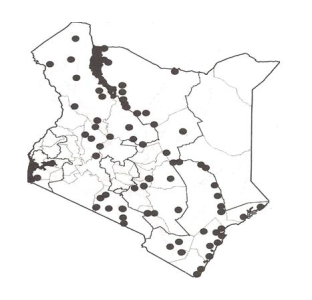Scientific name
Salvadora persica
Order / Family
Salvadoraceae
Local Names
Boran (Huda); Chonyi (Muswaki); Digo (Muswaki); English (toothbrush tree,mustard tree,salt bush); Gabra (Aadde); Giriama (Mjungumoto); Kamba (Mukayau); Kambe (Muezamoyo); Luo (Nyamit amita); Maasai (Oremit); Orma (adhe); Pokomo (Muade); Pokot (Chokowo); Rendile (Hayay); Samburu (Sokotu); Sanya (Adhei); Somali (Adhee); Swahili (Mswaki); Taita (Kizingumoto); Tugen (Sogotaiwa); Turkana (Esokon).
Introduction
General Distribution:
Is native to; Algeria, Angola, Cameroon, Chad, Egypt, Eritrea, Ethiopia, India, Iran, Israel, Jordan, Kenya, Libyan Arab Jamahiriya, Malawi, Mali, Mauritania, Mozambique, Niger, Nigeria, Oman, Pakistan, Saudi Arabia, Senegal, Somalia, South Africa, Sri Lanka, Sudan, Syrian Arab Republic, Tanzania, Uganda, Yemen, Republic of, Zambia and Zimbabwe and has spread to other parts of the continent.
 |
| Distribution of Salvadora persica in Kenya |
| © Maundu P. and Bo Tengnas. (2005). Useful trees and shrubs for Kenya, World Agroforestry Centre. |
General Information about the Tree:
Its fruits are eaten whole and have a slightly hot taste. Leaves and fruit are important fodder for camels and goats in dry areas when nothing else is available. The bark contains an antibiotic that keeps the mouth clean and prevents tooth decay.
Biophysical Limits:
Grows in most low latitude areas of Kenya, especially ASALS and coastal regions in riverine vegetation on sandy, sandy-loam and alluvial soils or on rocky ground. Altitude ranges between 0 and 1,800 m above sea level. It is very drought resistant; tolerates areas with less than 200 mm annual rainfall. It is an indicator plant for saline soils though it prefers sandy-clay soils of watercourses and occasionally found in red soils in bush land. Spread in agro-ecological zones V-VI.
Propagation and Tree Management
Seeds dispersed by animals and man after they eat the fruit. Propagation is by using seedlings but it produces root suckers which can also be used. It is slow growing. Shade trees should be planted near other trees such a A. tortilis for support. Pollarding is done for fodder and production of short stems to be harvested for toothbrushes.
It occurs in Woodlot, hedges and enrichment systems. To get high seed settings and seed oil content, harvesting is recommended 3 months after seed setting. This may be due to the utilization of food reserve in the cotyledons for the development of fruit pulp, and can be seen as the pulp content of fruit increases.
Coppicing is advantageous for the trees' use as a fuel, and the branches are repeatedly cut to produce short stems that are harvested for toothbrushes. It is generally a slow-growing tree.
Coppicing is advantageous for the trees' use as a fuel, and the branches are repeatedly cut to produce short stems that are harvested for toothbrushes. It is generally a slow-growing tree.
Products:
- Food: its fruits have a sweet, agreeable, aromatic, slightly pungent and peppery taste and they can be eaten raw, cooked, or dried and stored.
- Toothbrush; as the name suggests, it is a good source of tooth brush.
- Fodder: Leaves and young shoots are browsed by all stock, but normally cattle do not occur in the driest parts where its found and hence it tends to be valued more as a camel, sheep and goat forage.
- Apiculture: S. persica is a good source of nectar.
- Fuel: The wood is sometimes used for firewood and charcoal but it should not be used for cooking meat, as it leaves a foul taste.
- Timber: The wood is soft, white, easy to work and is not liable to termite attack. Used for coffins and clubs.
- Gum or resin: Resin that drips from the tree is supposedly useful for making varnish
 |
| A toothbrush from Salvadora persica |
| © Bo Tengnas |
Services:
- Shade or shelter: it is planted as shelter belts and windbreaks to protect farm habitation, gardens and orchards.
- Reclamation: used in sand dune reclamation and also useful for reclaiming saline soils.
Pests and Diseases
When it occurs on river terraces, it is a preferred host of Cistanche tubulosa, an obligate phanerogamic root parasite. Defoliating larvae of several beetles can attack the tree too, and leaves are often susceptible to attacks by the lepidopteran Colotis ephiae. The mite Eriophyes causes leaf gall and a number of fungi such as Cercospora udaipurensis, Placosoma salvadorae and Sephogloeum salvadorae damage the leaves.
Information Source Links
- ICRAF. 1992. A selection of useful trees and shrubs for Kenya: Notes on their identification, propagation and management for use by farming and pastoral communities. ICRAF.
- Albrecht J. ed. 1993. Tree seed hand book of Kenya. GTZ Forestry Seed Center Muguga, Nairobi, Kenya.
